|
The Sausage Saga, part 3: The bratwurst: the king of wurst!
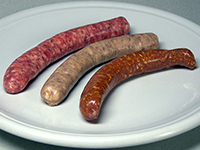
French wurst made out of duck meat,
Italian wurst made out of pork,
and Moroccan Merguez made of lamb. |
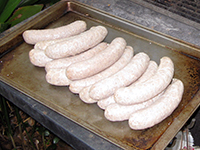
Hand-crafted raw bratwurst
from a private butcher shop in Texas,
prepared for grilling. |
And now, finally, on to Bratwurst. It needs to be said right at the beginning that
bratwursts are a global phenomenon, by far not just German. There are bratwursts made
in Germany, France, Italy, north Africa, the Americas, etc. Bratwursts are a diverse bunch:
most of them fall in the category of Brühwurst, some in Rohwurst.
Bratwursts come either raw or cooked. On the basis of grain size, just like rocks in geology,
Bratwursts are classified as fine-grained, medium-grained and coarse-grained.
The medium- and coarse-grained varieties are collectively known under the synonum
"Rostbratwurst" (bratwurst for grilling). It is the Rostbratwursts that anyone
who loves outdoor grilling is intimately familiar with.

Brät - sausage mixture
before insertion into casing. |
Although most bratwursts are ideally suited for grilling, the origin of the name
may or may not come from the German word "braten" (fry or roast). Most agree that the
name has its origin in the German word Brät, which simply means a minced or finely ground meat
mixture prepared for stuffing into sausage casing. It stems from an old High-German word brāto
meaning lean meat. However, a double origin of the word Bratwurst is not excluded.
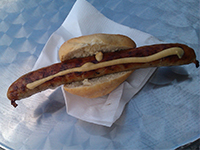
Thüringer Rostbratwurst served on a bun with mustard. |
The first bratwurst that comes to mind, and probably the most famous one,
is the Thüringer Rostbratwurst from the German state of Thuringia (Thüringen).
It is long and thick, 15-20 cm or 6-8 inches, weighing ~125 grams, with a spicy note.
This is a fabulous grilling wurst! Technically a Rohwurst, because it is delivered
completely uncooked, it is long and thick, and lean. It is traditionally made exclusively of ground pork,
lightly seasoned with salt, pepper, marjoram, caraway seeds and garlick, in pork-intestine casing.
Grain size is about 3 mm. The distinct blend of spices, mainly marjoram,
sets this bratwurst aside from the dozens of unique types of German bratwursts.
Thüringer Rostbratwursts are traditionally grilled over a charcoal fire
and eaten with mustard and bread or on a bun.
Documented history of this bratwurst goes back to the year 1404 to the town of
Arnstadt in Thuringia.
Moving southwest, one arrives in the realm of the Franconian bratwursts.
Franconia was an important historic Duchy in medieval Germany, now divided between the German states
Hessen, Rheinland-Pfalz and Bavaria. Many excellent types of bratwurst come from Franconia.
Wurst-making is said to date back to 1573. Franconian bratwursts tento be similar in size
to the Thüringer Rostbratwurst, but coarser-grained. Like with the
Thüringer Rostbratwurst, marjoram is again the principal spice.
White pepper, paprika and mace are also used. They are typically served with
potato salad or sauerkraut.
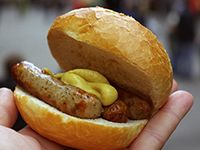
A trio of Nürnberger Rostbratwurst
(Drei in an Weggla)
served on a bun with mustard. |
In Nürnberg, the bratwurst tradition was first documented in 1313. It is therefore 700 years old!
Traditional Nürnberger bratwurst comes in two varieties: short and thin and long and thick.
Both, including the larger variety, are thinner than other bratwursts from Franconia.
This is a Brühwurst, made of pork seasoned with fresh marjoram,
which gives them their distinctive flavor. Grain size is about 3 mm.
They are traditionally grilled over a beechwood fire. The smaller variery,
known as Nürnberger Rostbratwurst, is an iconic Bratwurst. It is small and thin,
only about 7 to 9 cm (3-4 inches) long.
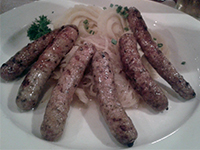
Six Nürnberger Rostbratwursts
(Sechs auf Kraut) served with sauerkraut,
Bei Otto in Bangkok. |
They can be served on a plate with either sauerkraut or potato salad in sets of 6 or 12,
and accompanied by a horseradish or mustard. This is commonly refered to as
"Sechs auf Kraut" or "Sechs mit Salat", respectively.
The are also eaten as street food on a hamburger bun with mustard. They usually come in threes and
are refered to in the local lingo as "Drei in an Weggla".
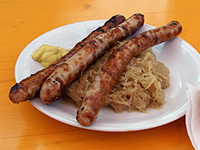
Large Nürnberger Bratwurst served over sauerkraut. |
The larger variety, known as Nürnberger Bratwurst, is about twice as big and twice as heavy
as the Rostbratwurst, with a coarser grain, about 5 mm. Also a Brühwurst like the smaller version,
it is typically served
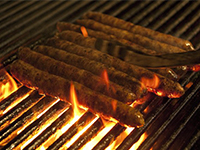
Coburger Bratwurst on the grill. |
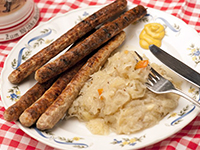
Coburger Bratwurst served with sauerkraut. |
Coburger Bratwurst is another Bratwurst from Franconia, first documented in 1498.
It is a Rohwurst, made from a minimum of 15% veal or beef, held together with eggs.
Its seasonings include only salt, pepper, nutmeg, and lemon zest.
It is coarse in texture and measures about 25 cm in length (nearly a foot).
Traditionally, it is grilled over pinecones and served in a roll.
Hofer and Kulmbacher Bratwursts are both Rohwursts from Oberfranken, from the towns of Hof and Kulmbach, respectively.
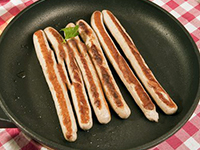
Pan-fried Hofer Bratwurst. |

Raw Hofer Bratwurst. |
They are both Rohwursts, thin, long and very fine grained.
To prepare the Hofer sausage lean pork and some beef is used. The sausage is seasoned with salt, pepper, nutmeg and lemon peel; However, the exact mixture is closely guarded trade secret of the butcher.
The Hofer Bratwurst has some similarity with the Kulmbach bratwurst. As this is relatively thin and long. The Hofer sausage is very fine and thin. The meat is very finely gekuttert with the addition of ice. The meat is then filled each about 50 grams in hog casings with a diameter of 18-22 mm. Hofer Bratwurst is usually sold and eaten in pairs.

Kulmbacher Bratwurst served in a bun. |
The Kulmbacher is a fine-grained Rohwurst from the town of Kulmbach in Oberfranken.
The Kulmbach Brawtwurst has some similarity with the Hofer bratwurst. As this is also the Kulmbach sausage very thin and long, but the Kulmbach sausage is characterized by a high proportion of veal. The meat for the sausage Kulmbach is very fine gekuttert with the addition of ice. The sausage is very fine and thin and not as coarse as, for example, the Coburg bratwurst.
The Kulmbach Brawtwurst is usually fried and then served in a sausage tunnel, an elongated, sprinkled with anise rolls. In these Stölla fit three Kulmbach sausages.
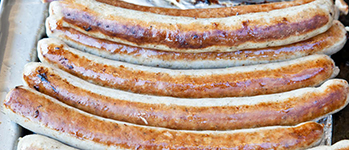
Würzburger Bratwurst. |
Würzburger Bratwurst, or Winzerbratwurst, is yet another example of Franconian Bratwurst.
It is a Rohwurst, in size similar to the Thüringer Rostbratwurst, but its ingredients include white Franken-Wine.
It is a recent addition to the family of Franconian wurst, having been invented in the 1980s.
The "Würzburg Bratwurst" was created in a competition organized by the mayor of Würzburg,
Kurt Zeitler (in office 1968-1990), who called upon an competition to invent an original wurst
that would be native to the city of Würzburg.
Here is a nice summary of Franconian wurst .
To the west, in the Palatine (Pfälz), there is the Pfälzer Bratwurst
characterized by a very coarse grain, much coarser then the Thuringian or Franconian bratwurst.
They are made made exclusively from pork (pork shoulder, pork belly and/or back fat).
The meat is coarsely ground and seasoned with salt, white pepper, fresh garlic, coriander, nutmeg and other spices.
The mixture is stuffed into natural casings and finished in pieces 15 cm long, about 2.5-3 cm thick,
It comes either as a Rohwurst or as a Brühwurst for longer shelf life.

Weisswurst with mustard and a pretzel. |
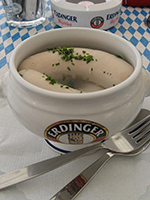
Weisswurst served in a bowl. |
A special place in the world of Bratwurst is occupied by the
Munich white bratwurst (Münchner Weisswurst).
It is a traditionally made of veal, today also pork, very finely ground, and seasoned with
a delicate blend of parsley, lemon, mace, onions, ginger and cardamom,
stuffed into a pork-intestine casing. It is separated into individual sausages
10-12 cm (4-5 inches) and about 2 centimeters (1 inch) in thickness. It is prepared by boiling
and served in pairs, either in a traditional white porcelain bowl with a lid,
or on a plate, and eaten with a pretzel and sweet bavarian mustard.
The casing is never eaten (only Weisswurst greenhorns would do that...).
A step-by-step instruction in proper Weisswurst consumption is given
here.
Weisswurst is said to have been invented in 1857 at the pub "Zum Ewigen Licht"
(The Eterlan Light, now Café "Am Marienplatz") on Marienplatz in Munich.

Bockwurst served on the street with mustard and a bread roll. |
And other German wurst? There is the Bockwurst, a relatively recent addition to the world of wurst,
only dating back to the lat 19th centory. It is a German sausage from Berlin,
made of ground beef and veal, seasoned with salt, white pepper and paprika, and stuffed into a thin casing.
Bockwurst is often smoked as well. It can be similar in looks, size and texture to
the Wiener Würstchen and Frankfurter Würstchen.
All three fall into the category of very fine-grained Brühwürst.
The name bockwurst (but not the sausage itself) is attributed to Richard Scholtz,
a restaurateur who ran a pub in Berlin. A Jewish butcher named Benjamin Loewenthal
had been making this sausage, which Scholtz served to his guests, students and faculty from
the University of Berlin Unter den Linden. They held a piss-up to commemorate the beginning
of the winter semester of 1889, and Scholtz served them Loewenthal's sausage along with
Tempelhof Bock, brewed in Berlin by a Bavarian brewer named Leonhard Hopf. Story
has it that the students and faculty, once sufficiently sauced, invented the term
"bockwurst" for Loewenthal's sausage.
For years, bockwurst she has served in Berlin with fried potatoes and brown gravy.
It was not until the end of the 19th century that it began to be served with mustard
in the English way. Today, bockwurst is usually cooked by simmering although it can also be grilled.
Boiling should be avoided as the casing may split open and the Bockwurst may look
unappetizing and leak flavor to the boiling water.
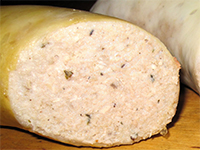
Coarse-grained knackwurst. |

Fine-grained knackwurst. |
Knackwursts are various types of mostly fatty wurst. German knackwursts fall in the Rohwürst und Brühwürst
categories, Austrian knackwursts are Brühwurst.
They can be fine-grained to very-fine-grained, typically made of beef, fatty pork or pure fat.
Pork-intestine or bovine small-intestine casings are used.
The name Knackwurst is derived from the German word for the cracking sound made when the casing is bitten into.
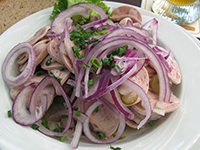
Wurstsalat served with dark bread. |
In comparison with bratwursts, in our opinion knackwursts are a lesser wurst,
becauwse they are not as deliciously seasoned and typically much more fatty.
They are generally not suitable for grilling. However, many are delicious and
and are used in many great recipes, such as the Wurst salad. For this dish, the knackwurst is sliced,
sprinkled with thinly sliced onion and dressed with oil and vinegar.
Among Rohwursts, there are:
- Berlin Knackwurst, made from lean pork, lean beef and pork belly. The mixture medium-grained,
seasoned with nitrite pickling salt, pepper and mustard seeds. Pork-intestine casings
about 30 mm in diameter are used. The wurst is cold-smoked and left to mature for several days.
- Saxonian Knackwurst made of lean beef and fatty pork belly, seasoned with pickling salt and pepper
- Thuringian country Knackwurst made lean pork and bacon, pickled with salt, seasoned with pepper, cumin and garlic
- Thin Thuringian Knackwurst: like a weenie in shape and size, made of lean beef and fatty pork belly, seasoned with pickling salt, white pepper, cumin and garlic
- Thick Thuringian Knackwurst: cut resistant Rohwurst, made of lean beef, lean pork and bacon, seasoned either with pickling salt, pepper, cumin and nutmeg, or with pickling salt, white pepper, allspice and flavored with rum, stuffed into small bovine intestine casings 46 mm in diameter
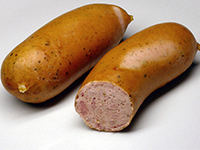
Regensburger Knackwurst. |
Among Brühwursts, there are:
- Frankfurt Knackwürstchen, Knackwürstchen or Hamburger Knackwurst: fine-grained, hot-smoked, 80-120 g in weight
- Augsburg Knackwurst: hot-smoked pork sausage consisting of lean pork and pre-cooked bacon, seasoned with pickling salt, mace and allspice, filled into pork-intestine casings with a diameter of 30-75 mm
- Regensburg Knackwurst: hot-smoked pork sausage consisting of pork belly without skin and lean pork, seasoned with pickling salt, pepper, lemon powder, mace and raw onions, stuffed into bovine small-intestine casing 37-40 mm, prepared in 4-5 cm long sausages
- Stuttgart Knackwurst: hot-smoked pork and beef sausage seasoned with pickling salt, pepper, nutmeg and allspice, stuffed into pork-intestine casing with a diameter of about 30 mm
Austrian knackwursts are small varieties of "Extrawurst", a thick sausage of a very smooth texture, suitable for slicing.
It is a Brühwurst made of beef, pork, bacon and a little potato starch. They have a typical weight of 120-150 g.
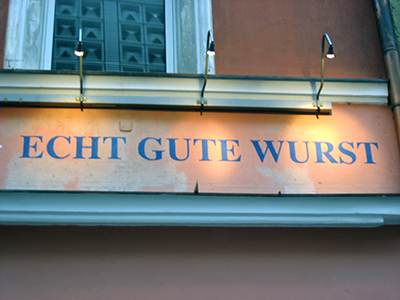
Sources:
- Exhibit "Sousedé na talíři, Die Nachbarn auf dem Teller" held 2011 - August 2011 in Brno, Czech Republic
- Nuernberginfos.de
- Fleischtheke.info
- Würstchen.de
- Wurstakademie.com
- Wurst.de
- Wikipedia
back to Radim and Lisa's Well-Travelled Cookbook | email us
Last updated: May 10, 2014
Certain images from Wikimedia Commons, used under the terms of the GNU Free Documentation License.
|



















